您好,登錄后才能下訂單哦!
您好,登錄后才能下訂單哦!
這篇文章主要介紹了Springboot基于Redisson如何實現Redis分布式可重入鎖源碼解析,具有一定借鑒價值,感興趣的朋友可以參考下,希望大家閱讀完這篇文章之后大有收獲,下面讓小編帶著大家一起了解一下。
我們在實現使用Redis實現分布式鎖,最開始一般使用SET resource-name anystring NX EX max-lock-time進行加鎖,使用Lua腳本保證原子性進行實現釋放鎖。這樣手動實現比較麻煩,對此Redis官網也明確說Java版使用Redisson來實現。小編也是看了官網慢慢的摸索清楚,特寫此記錄一下。從官網到整合Springboot到源碼解讀,以單節點為例。
redis中文官網
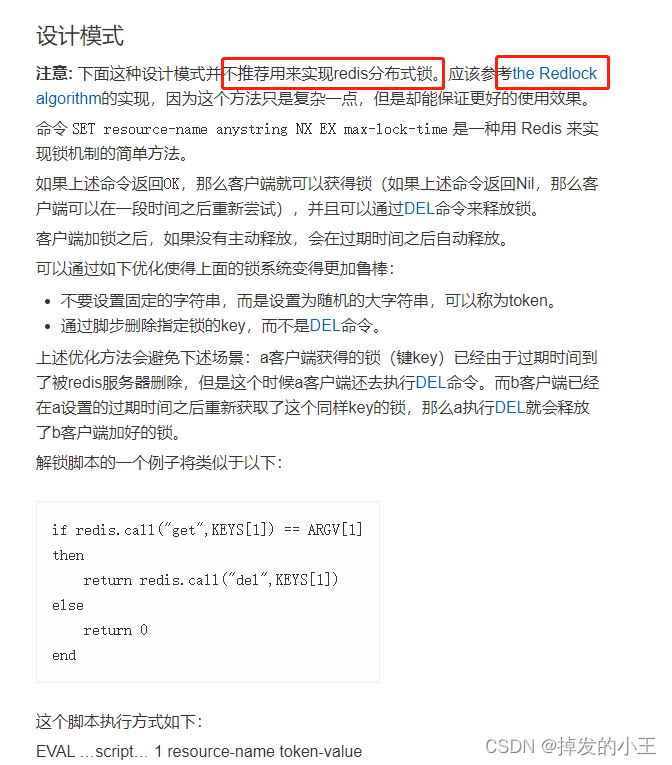

Redisson地址
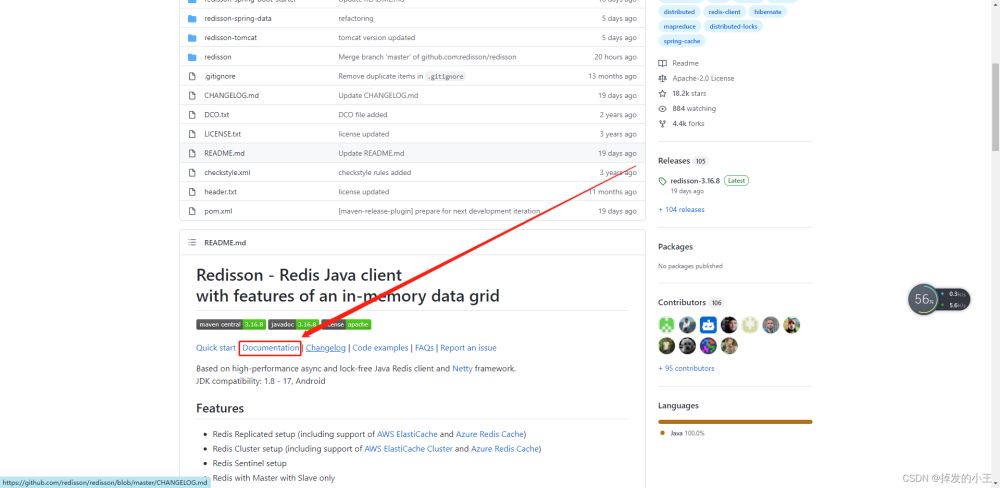
5. Redisson結構
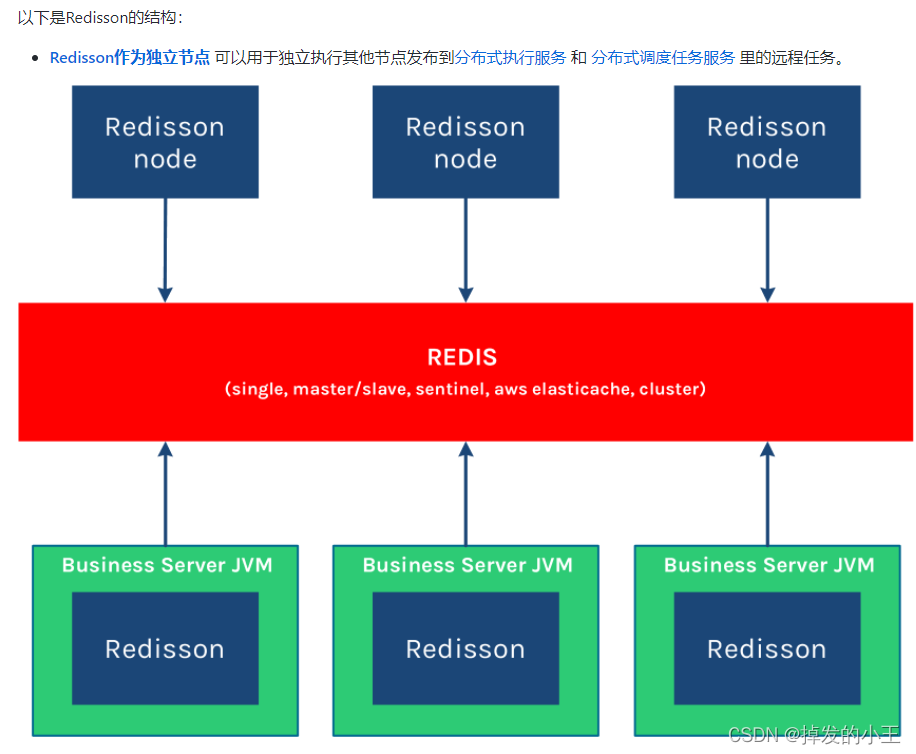
<dependency> <groupId>org.springframework.boot</groupId> <artifactId>spring-boot-starter-data-redis</artifactId> </dependency> <dependency> <groupId>redis.clients</groupId> <artifactId>jedis</artifactId> </dependency> <!--redis分布式鎖--> <dependency> <groupId>org.redisson</groupId> <artifactId>redisson</artifactId> <version>3.12.0</version> </dependency>

import org.redisson.Redisson;
import org.redisson.api.RedissonClient;
import org.redisson.config.Config;
import org.springframework.context.annotation.Bean;
import org.springframework.context.annotation.Configuration;
/**
* @author wangzhenjun
* @date 2022/2/9 9:57
*/
@Configuration
public class MyRedissonConfig {
/**
* 所有對redisson的使用都是通過RedissonClient來操作的
* @return
*/
@Bean(destroyMethod="shutdown")
public RedissonClient redisson(){
// 1. 創建配置
Config config = new Config();
// 一定要加redis://
config.useSingleServer().setAddress("redis://192.168.17.130:6379");
// 2. 根據config創建出redissonClient實例
RedissonClient redissonClient = Redisson.create(config);
return redissonClient;
}
}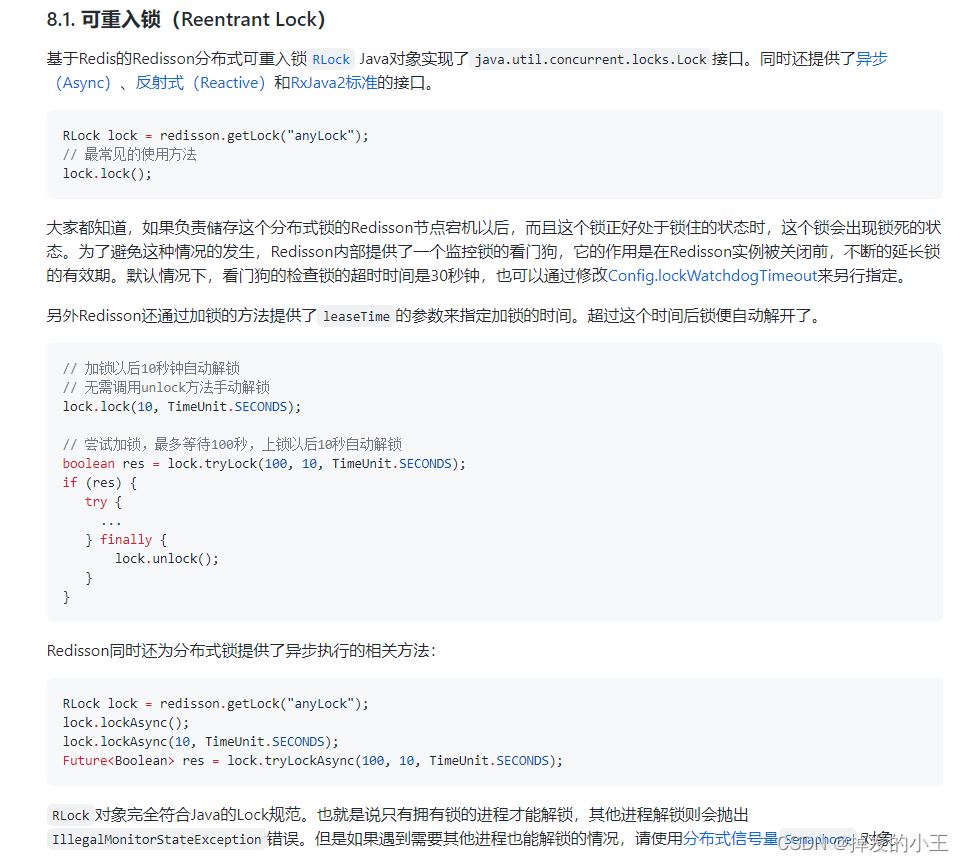
@ResponseBody
@GetMapping("/hello")
public String hello(){
// 1.獲取一把鎖,只要鎖名字一樣,就是同一把鎖
RLock lock = redisson.getLock("my-lock");
// 2. 加鎖
lock.lock();// 阻塞試等待 默認加的都是30s
// 帶參數情況
// lock.lock(10, TimeUnit.SECONDS);// 10s自動解鎖,自動解鎖時間一定要大于業務的執行時間。
try {
System.out.println("加鎖成功" + Thread.currentThread().getId());
Thread.sleep(30000);
} catch (InterruptedException e) {
e.printStackTrace();
} finally {
// 3. 解鎖
System.out.println("解鎖成功:" + Thread.currentThread().getId());
lock.unlock();
}
return "hello";
}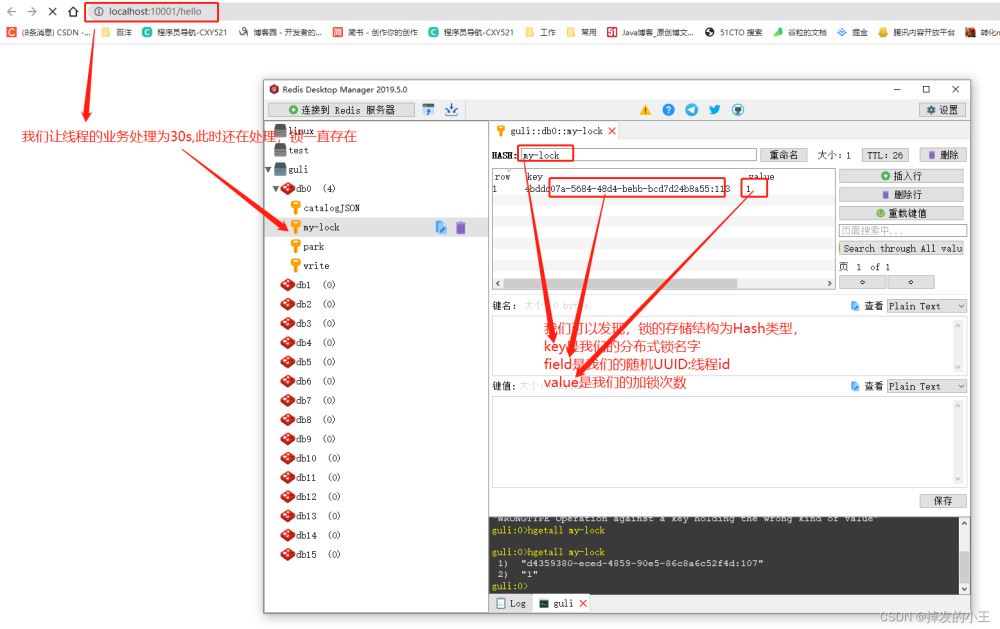

@Override
public void lock() {
try {
// 我們發現不穿過期時間源碼默認過期時間為-1
lock(-1, null, false);
} catch (InterruptedException e) {
throw new IllegalStateException();
}
}private void lock(long leaseTime, TimeUnit unit, boolean interruptibly) throws InterruptedException {
// 獲取線程的id,占有鎖的時候field的值為UUID:線程號id
long threadId = Thread.currentThread().getId();
// 嘗試獲得鎖
Long ttl = tryAcquire(leaseTime, unit, threadId);
// lock acquired 獲得鎖,返回
if (ttl == null) {
return;
}
// 這里說明獲取鎖失敗,就通過線程id訂閱這個鎖
RFuture<RedissonLockEntry> future = subscribe(threadId);
if (interruptibly) {
commandExecutor.syncSubscriptionInterrupted(future);
} else {
commandExecutor.syncSubscription(future);
}
try {
// 這里進行自旋,不斷嘗試獲取鎖
while (true) {
// 繼續嘗試獲取鎖
ttl = tryAcquire(leaseTime, unit, threadId);
// lock acquired 獲取成功
if (ttl == null) {
// 直接返回,挑出自旋
break;
}
// waiting for message 繼續等待獲得鎖
if (ttl >= 0) {
try {
future.getNow().getLatch().tryAcquire(ttl, TimeUnit.MILLISECONDS);
} catch (InterruptedException e) {
if (interruptibly) {
throw e;
}
future.getNow().getLatch().tryAcquire(ttl, TimeUnit.MILLISECONDS);
}
} else {
if (interruptibly) {
future.getNow().getLatch().acquire();
} else {
future.getNow().getLatch().acquireUninterruptibly();
}
}
}
} finally {
// 取消訂閱
unsubscribe(future, threadId);
}
// get(lockAsync(leaseTime, unit));
}
private Long tryAcquire(long leaseTime, TimeUnit unit, long threadId) {
// 直接進入異步方法
return get(tryAcquireAsync(leaseTime, unit, threadId));
}
private <T> RFuture<Long> tryAcquireAsync(long leaseTime, TimeUnit unit, long threadId) {
// 這里進行判斷如果沒有設置參數leaseTime = -1
if (leaseTime != -1) {
return tryLockInnerAsync(leaseTime, unit, threadId, RedisCommands.EVAL_LONG);
}
// 此方法進行獲得鎖,過期時間為看門狗的默認時間
// private long lockWatchdogTimeout = 30 * 1000;看門狗默認過期時間為30s
// 加鎖和過期時間要保證原子性,這個方法后面肯定調用執行了Lua腳本,我們下面在看
RFuture<Long> ttlRemainingFuture = tryLockInnerAsync(commandExecutor.getConnectionManager().getCfg().getLockWatchdogTimeout(), TimeUnit.MILLISECONDS, threadId, RedisCommands.EVAL_LONG);
// 開啟一個定時任務進行不斷刷新過期時間
ttlRemainingFuture.onComplete((ttlRemaining, e) -> {
if (e != null) {
return;
}
// lock acquired 獲得鎖
if (ttlRemaining == null) {
// 刷新過期時間方法,我們下一步詳細說一下
scheduleExpirationRenewal(threadId);
});
return ttlRemainingFuture;<T> RFuture<T> tryLockInnerAsync(long leaseTime, TimeUnit unit, long threadId, RedisStrictCommand<T> command) {
internalLockLeaseTime = unit.toMillis(leaseTime);
return commandExecutor.evalWriteAsync(getName(), LongCodec.INSTANCE, command,
// 首先判斷鎖是否存在
"if (redis.call('exists', KEYS[1]) == 0) then " +
// 存在則獲取鎖
"redis.call('hset', KEYS[1], ARGV[2], 1); " +
// 然后設置過期時間
"redis.call('pexpire', KEYS[1], ARGV[1]); " +
"return nil; " +
"end; " +
// hexists查看哈希表的指定字段是否存在,存在鎖并且是當前線程持有鎖
"if (redis.call('hexists', KEYS[1], ARGV[2]) == 1) then " +
// hincrby自增一
"redis.call('hincrby', KEYS[1], ARGV[2], 1); " +
// 鎖的值大于1,說明是可重入鎖,重置過期時間
"redis.call('pexpire', KEYS[1], ARGV[1]); " +
"return nil; " +
"end; " +
// 鎖已存在,且不是本線程,則返回過期時間ttl
"return redis.call('pttl', KEYS[1]);",
Collections.<Object>singletonList(getName()), internalLockLeaseTime, getLockName(threadId));
}一步步往下找源碼:scheduleExpirationRenewal --->renewExpiration
根據下面源碼,定時任務刷新時間為:internalLockLeaseTime / 3,是看門狗的1/3,即為10s刷新一次
private void renewExpiration() {
ExpirationEntry ee = EXPIRATION_RENEWAL_MAP.get(getEntryName());
if (ee == null) {
return;
}
Timeout task = commandExecutor.getConnectionManager().newTimeout(new TimerTask() {
@Override
public void run(Timeout timeout) throws Exception {
ExpirationEntry ent = EXPIRATION_RENEWAL_MAP.get(getEntryName());
if (ent == null) {
return;
}
Long threadId = ent.getFirstThreadId();
if (threadId == null) {
return;
}
RFuture<Boolean> future = renewExpirationAsync(threadId);
future.onComplete((res, e) -> {
if (e != null) {
log.error("Can't update lock " + getName() + " expiration", e);
return;
}
if (res) {
// reschedule itself
renewExpiration();
}
});
}
}, internalLockLeaseTime / 3, TimeUnit.MILLISECONDS);
ee.setTimeout(task);
}1. 打開實現類
@Override
public void lock(long leaseTime, TimeUnit unit) {
try {
// 這里的過期時間為我們輸入的10
lock(leaseTime, unit, false);
} catch (InterruptedException e) {
throw new IllegalStateException();
}
}2. 方法lock()實現展示,同三.3源碼
3. 直接來到嘗試獲得鎖tryAcquireAsync()方法
private <T> RFuture<Long> tryAcquireAsync(long leaseTime, TimeUnit unit, long threadId) {
// 這里進行判斷如果沒有設置參數leaseTime = -1,此時我們為10
if (leaseTime != -1) {
// 來到此方法
return tryLockInnerAsync(leaseTime, unit, threadId, RedisCommands.EVAL_LONG);
}
// 此處省略后面內容,前面以詳細說明。。。。
}4. 打開tryLockInnerAsync()方法
我們不難發現和沒有傳過期時間的方法一樣,只不過leaseTime的值變了。
<T> RFuture<T> tryLockInnerAsync(long leaseTime, TimeUnit unit, long threadId, RedisStrictCommand<T> command) {
internalLockLeaseTime = unit.toMillis(leaseTime);
return commandExecutor.evalWriteAsync(getName(), LongCodec.INSTANCE, command,
// 首先判斷鎖是否存在
"if (redis.call('exists', KEYS[1]) == 0) then " +
// 存在則獲取鎖
"redis.call('hset', KEYS[1], ARGV[2], 1); " +
// 然后設置過期時間
"redis.call('pexpire', KEYS[1], ARGV[1]); " +
"return nil; " +
"end; " +
// hexists查看哈希表的指定字段是否存在,存在鎖并且是當前線程持有鎖
"if (redis.call('hexists', KEYS[1], ARGV[2]) == 1) then " +
// hincrby自增一
"redis.call('hincrby', KEYS[1], ARGV[2], 1); " +
// 鎖的值大于1,說明是可重入鎖,重置過期時間
"redis.call('pexpire', KEYS[1], ARGV[1]); " +
"return nil; " +
"end; " +
// 鎖已存在,且不是本線程,則返回過期時間ttl
"return redis.call('pttl', KEYS[1]);",
Collections.<Object>singletonList(getName()), internalLockLeaseTime, getLockName(threadId));
}1. 打開方法實現
@Override
public void unlock() {
try {
// 點擊進入釋放鎖方法
get(unlockAsync(Thread.currentThread().getId()));
} catch (RedisException e) {
if (e.getCause() instanceof IllegalMonitorStateException) {
throw (IllegalMonitorStateException) e.getCause();
} else {
throw e;
}
}
// Future<Void> future = unlockAsync();
// future.awaitUninterruptibly();
// if (future.isSuccess()) {
// return;
// }
// if (future.cause() instanceof IllegalMonitorStateException) {
// throw (IllegalMonitorStateException)future.cause();
// }
// throw commandExecutor.convertException(future);
}2. 打開unlockAsync()方法
@Override
public RFuture<Void> unlockAsync(long threadId) {
RPromise<Void> result = new RedissonPromise<Void>();
// 解鎖方法,后面展開說
RFuture<Boolean> future = unlockInnerAsync(threadId);
// 完成
future.onComplete((opStatus, e) -> {
if (e != null) {
// 取消到期續訂
cancelExpirationRenewal(threadId);
// 將這個未來標記為失敗并通知所有人
result.tryFailure(e);
return;
}
// 狀態為空,說明解鎖的線程和當前鎖不是同一個線程
if (opStatus == null) {
IllegalMonitorStateException cause = new IllegalMonitorStateException("attempt to unlock lock, not locked by current thread by node id: "
+ id + " thread-id: " + threadId);
result.tryFailure(cause);
return;
}
cancelExpirationRenewal(threadId);
result.trySuccess(null);
});
return result;
}3. 打開unlockInnerAsync()方法
protected RFuture<Boolean> unlockInnerAsync(long threadId) {
return commandExecutor.evalWriteAsync(getName(), LongCodec.INSTANCE, RedisCommands.EVAL_BOOLEAN,
// 判斷釋放鎖的線程和已存在鎖的線程是不是同一個線程,不是返回空
"if (redis.call('hexists', KEYS[1], ARGV[3]) == 0) then " +
"return nil;" +
"end; " +
// 釋放鎖后,加鎖次數減一
"local counter = redis.call('hincrby', KEYS[1], ARGV[3], -1); " +
// 判斷剩余數量是否大于0
"if (counter > 0) then " +
// 大于0 ,則刷新過期時間
"redis.call('pexpire', KEYS[1], ARGV[2]); " +
"return 0; " +
"else " +
// 釋放鎖,刪除key并發布鎖釋放的消息
"redis.call('del', KEYS[1]); " +
"redis.call('publish', KEYS[2], ARGV[1]); " +
"return 1; "+
"end; " +
"return nil;",
Arrays.<Object>asList(getName(), getChannelName()), LockPubSub.UNLOCK_MESSAGE, internalLockLeaseTime, getLockName(threadId));
}感謝你能夠認真閱讀完這篇文章,希望小編分享的“Springboot基于Redisson如何實現Redis分布式可重入鎖源碼解析”這篇文章對大家有幫助,同時也希望大家多多支持億速云,關注億速云行業資訊頻道,更多相關知識等著你來學習!
免責聲明:本站發布的內容(圖片、視頻和文字)以原創、轉載和分享為主,文章觀點不代表本網站立場,如果涉及侵權請聯系站長郵箱:is@yisu.com進行舉報,并提供相關證據,一經查實,將立刻刪除涉嫌侵權內容。